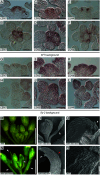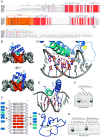The ALOG domain defines a family of plant-specific transcription factors acting during Arabidopsis flower development
- PMID: 38412122
- PMCID: PMC10927535
- DOI: 10.1073/pnas.2310464121
The ALOG domain defines a family of plant-specific transcription factors acting during Arabidopsis flower development
Abstract
The ALOG (Arabidopsis LIGHT-DEPENDENT SHORT HYPOCOTYLS 1 (LSH1) and Oryza G1) proteins are conserved plant-specific Transcription Factors (TFs). They play critical roles in the development of various plant organs (meristems, inflorescences, floral organs, and nodules) from bryophytes to higher flowering plants. Despite the fact that the first members of this family were originally discovered in Arabidopsis, their role in this model plant has remained poorly characterized. Moreover, how these transcriptional regulators work at the molecular level is unknown. Here, we study the redundant function of the ALOG proteins LSH1,3,4 from Arabidopsis. We uncover their role in the repression of bract development and position them within a gene regulatory network controlling this process and involving the floral regulators LEAFY, BLADE-ON-PETIOLE, and PUCHI. Next, using in vitro genome-wide studies, we identified the conserved DNA motif bound by ALOG proteins from evolutionarily distant species (the liverwort Marchantia polymorpha and the flowering plants Arabidopsis, tomato, and rice). Resolution of the crystallographic structure of the ALOG DNA-binding domain in complex with DNA revealed the domain is a four-helix bundle with a disordered NLS and a zinc ribbon insertion between helices 2 and 3. The majority of DNA interactions are mediated by specific contacts made by the third alpha helix and the NLS. Taken together, this work provides the biochemical and structural basis for DNA-binding specificity of an evolutionarily conserved TF family and reveals its role as a key player in Arabidopsis flower development.
Keywords: ALOG domain; flower development; plant transcription factors.
Conflict of interest statement
Competing interests statement:The authors declare no competing interest.
Figures




Similar articles
-
The origin and evolution of the ALOG proteins, members of a plant-specific transcription factor family, in land plants.J Plant Res. 2020 May;133(3):323-329. doi: 10.1007/s10265-020-01171-6. Epub 2020 Feb 12. J Plant Res. 2020. PMID: 32052256
-
ALOG domains: provenance of plant homeotic and developmental regulators from the DNA-binding domain of a novel class of DIRS1-type retroposons.Biol Direct. 2012 Nov 12;7:39. doi: 10.1186/1745-6150-7-39. Biol Direct. 2012. PMID: 23146749 Free PMC article.
-
CUP-SHAPED COTYLEDON1 transcription factor activates the expression of LSH4 and LSH3, two members of the ALOG gene family, in shoot organ boundary cells.Plant J. 2011 Jun;66(6):1066-77. doi: 10.1111/j.1365-313X.2011.04571.x. Epub 2011 Apr 12. Plant J. 2011. PMID: 21435050
-
ALOG/LSHs: a novel class of transcription factors that regulate plant growth and development.J Exp Bot. 2025 Feb 7;76(3):836-850. doi: 10.1093/jxb/erae409. J Exp Bot. 2025. PMID: 39361138 Review.
-
New insights into the regulation of inflorescence architecture.Trends Plant Sci. 2014 Mar;19(3):158-65. doi: 10.1016/j.tplants.2013.11.001. Epub 2013 Dec 3. Trends Plant Sci. 2014. PMID: 24315403 Review.
Cited by
-
Investigating how reproductive traits in rice respond to abiotic stress.J Exp Bot. 2025 May 27;76(8):2064-2080. doi: 10.1093/jxb/eraf031. J Exp Bot. 2025. PMID: 39876691 Free PMC article. Review.
-
Characterization and Expression Analysis of the ALOG Gene Family in Rice (Oryza sativa L.).Plants (Basel). 2025 Apr 14;14(8):1208. doi: 10.3390/plants14081208. Plants (Basel). 2025. PMID: 40284096 Free PMC article.
-
Behind phyllotaxis, within the meristem: a REM-ARF complex shapes inflorescence in Arabidopsis thaliana.Plant J. 2025 Mar;121(5):e70041. doi: 10.1111/tpj.70041. Plant J. 2025. PMID: 40025809 Free PMC article.
-
Chronology of transcriptome and proteome expression during early Arabidopsis flower development.J Exp Bot. 2025 Jul 2;76(10):2743-2762. doi: 10.1093/jxb/eraf005. J Exp Bot. 2025. PMID: 39774695 Free PMC article.
-
Sea-ATI unravels novel vocabularies of plant active cistrome.Nucleic Acids Res. 2023 Nov 27;51(21):11568-11583. doi: 10.1093/nar/gkad853. Nucleic Acids Res. 2023. PMID: 37850650 Free PMC article.
References
-
- Blanc-Mathieu R., Dumas R., Turchi L., Lucas J., Parcy F., Plant-TFClass: A structural classification for plant transcription factors. Trends Plant Sci. 29, 40–51 (2023). - PubMed
-
- Zhao L., et al. , Overexpression of LSH1, a member of an uncharacterised gene family, causes enhanced light regulation of seedling development. Plant J. 37, 694–706 (2004). - PubMed
-
- Naramoto S., Hata Y., Kyozuka J., The origin and evolution of the ALOG proteins, members of a plant-specific transcription factor family, in land plants. J. Plant Res. 133, 323–329 (2020). - PubMed
MeSH terms
Substances
Grants and funding
LinkOut - more resources
Full Text Sources
Molecular Biology Databases
Miscellaneous

